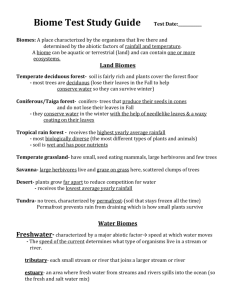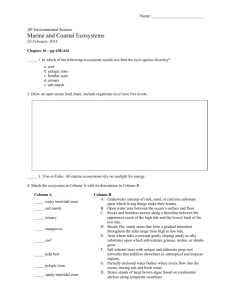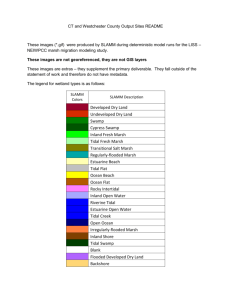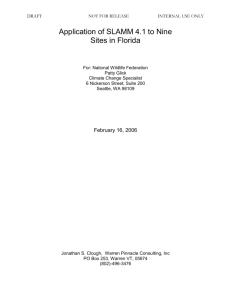Chapter 3 Study Guide for Chapter Test
advertisement
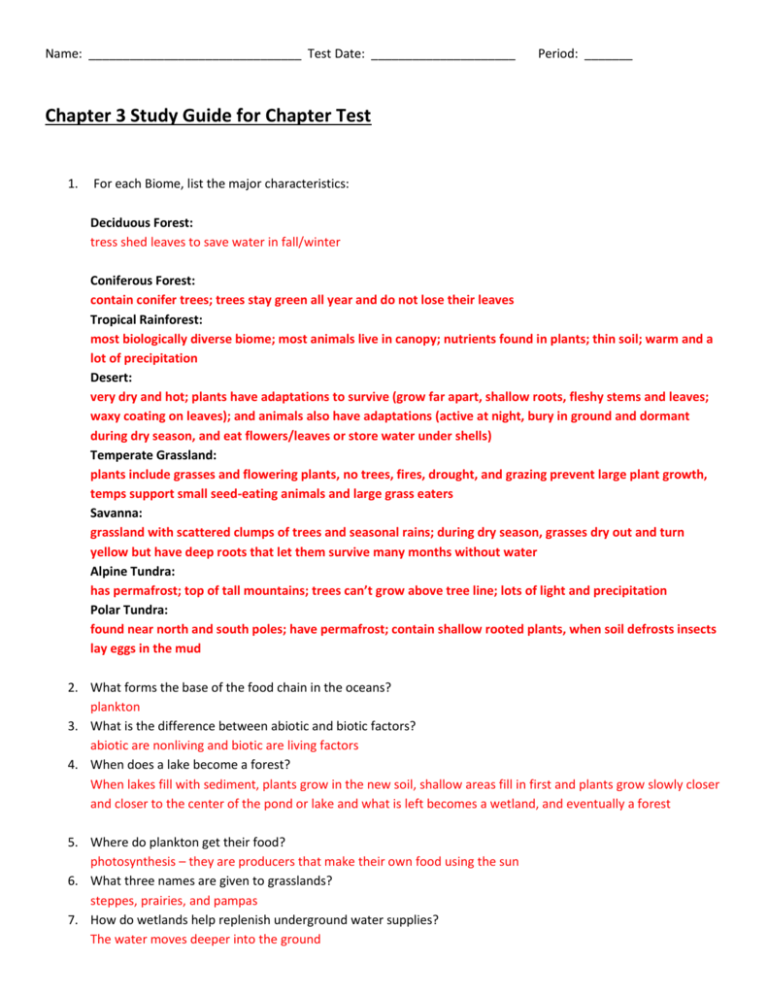
Name: _______________________________ Test Date: _____________________ Period: _______ Chapter 3 Study Guide for Chapter Test 1. For each Biome, list the major characteristics: Deciduous Forest: tress shed leaves to save water in fall/winter Coniferous Forest: contain conifer trees; trees stay green all year and do not lose their leaves Tropical Rainforest: most biologically diverse biome; most animals live in canopy; nutrients found in plants; thin soil; warm and a lot of precipitation Desert: very dry and hot; plants have adaptations to survive (grow far apart, shallow roots, fleshy stems and leaves; waxy coating on leaves); and animals also have adaptations (active at night, bury in ground and dormant during dry season, and eat flowers/leaves or store water under shells) Temperate Grassland: plants include grasses and flowering plants, no trees, fires, drought, and grazing prevent large plant growth, temps support small seed-eating animals and large grass eaters Savanna: grassland with scattered clumps of trees and seasonal rains; during dry season, grasses dry out and turn yellow but have deep roots that let them survive many months without water Alpine Tundra: has permafrost; top of tall mountains; trees can’t grow above tree line; lots of light and precipitation Polar Tundra: found near north and south poles; have permafrost; contain shallow rooted plants, when soil defrosts insects lay eggs in the mud 2. What forms the base of the food chain in the oceans? plankton 3. What is the difference between abiotic and biotic factors? abiotic are nonliving and biotic are living factors 4. When does a lake become a forest? When lakes fill with sediment, plants grow in the new soil, shallow areas fill in first and plants grow slowly closer and closer to the center of the pond or lake and what is left becomes a wetland, and eventually a forest 5. Where do plankton get their food? photosynthesis – they are producers that make their own food using the sun 6. What three names are given to grasslands? steppes, prairies, and pampas 7. How do wetlands help replenish underground water supplies? The water moves deeper into the ground 8. Why is the speed of water important in freshwater ecosystems? animals must adapt to not be washed away 9. Which biome is the most diverse and why? Tropical Rainforest – it contains more different types of plants and animals than any other biome 10. How is a swamp different from a marsh? A swamp has tees and a marsh does not 11. What are the three types of intertidal areas? mudflats, sandy beaches, and rocky shores 12. What makes it possible for many animals to live in the polar ice ecosystems? the large number of plankton forms a large base of the food chain 13. Distinguish between a swamp, a marsh and an estuary. Estuary – where salt water of ocean meets the fresh water of lakes and streams Swamp – Areas of standing water containing trees and vines, for example a willow tree Marsh – Treeless wetland ecosystem, where plants such as grasses grow; are often found in shallow areas along the shores of lakes, ponds, rivers and streams 14. Write the major characteristics of the following ecosystems: intertidal areas: where the water meets the shore, organisms have to adapt to being exposed to air part of the time and being swept away coral reefs: found in warm shallow waters in the neretic zone; is made of the skeletons of small animals called coral estuary: is where fresh water from rivers and streams mixes with the salt water of the oceans Sargasso Sea: area found in the Atlantic Ocean where there are huge, floating rafts of algae 15. What are three key abiotic factors in a marine ecosystem? 1. Water temperature 2. Water depth 3. Amount of sunlight 16. What are the four adaptations of desert plants? 1. Shallow, widespread roots 2. Grow far apart 3. Waxy coating of stems and leaves 4. Fleshy stems and leaves to hold water 17. Where are thermal vents found? Why are they important? Thermal vents are found on the ocean floor in the benthic zone. They are important because chemicals that escape from the vents create energy/food for the organisms that live there, such as bacteria. 18. List the four major ocean zones and explain where they are found in the ocean. 1. 2. 3. 4. Intertidal Zone – found at the shore line, where the ocean water meets the shore. Neretic Zone – found where the ocean floor just begins to slope downward and water begins to get deeper oceanic Zone – found where the ocean floor drops sharply and contains the deep water of the ocean benthic zone – found on the ocean floor




